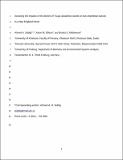| dc.contributor.author | Siddig, Ahmed Ali | |
| dc.contributor.author | Ellison, Aaron M. | |
| dc.contributor.author | Mathewson, Brooks | |
| dc.date.accessioned | 2017-07-20T18:43:38Z | |
| dc.date.issued | 2016 | |
| dc.identifier | Quick submit: 2017-05-04T11:55:36-0400 | |
| dc.identifier.citation | Siddig, Ahmed A. H., Aaron M. Ellison, and Brooks G. Mathewson. 2016. “Assessing the Impacts of the Decline ofTsuga Canadensisstands on Two Amphibian Species in a New England Forest.” Ecosphere 7 (11) (November): e01574. doi:10.1002/ecs2.1574. | en_US |
| dc.identifier.issn | 2150-8925 | en_US |
| dc.identifier.uri | http://nrs.harvard.edu/urn-3:HUL.InstRepos:33470134 | |
| dc.description.abstract | Disturbances such as outbreaks of herbivorous insects and pathogens can devastate unique habitats and directly reduce biodiversity. The foundation tree species Tsuga canadensis (eastern hemlock) is declining due to infestation by the nonnative insect Adelges tsugae (hemlock woolly adelgid). The decline and expected elimination of hemlock from northeastern U.S. forests is changing forest structure, function, and assemblages of associated species. We assessed 10 years of changes in occupancy, detection probability, and relative abundance of two species of terrestrial salamanders, Plethodon cinereus (eastern red-back salamander) and Notopthalmus viridescens viridescens (eastern red-spotted newt), to the experimental removal in 2005 of T. canadensis at Harvard Forest. Salamanders were sampled under cover boards and using visual encounter surveys before (2004) and after (2005, 2013, 2014) canopy manipulations in replicate 0.81-ha plots. In 2004, occupancy of P. cinereus was 35% lower in stands dominated by T. canadensis than that in associated mixed-hardwood control stands, whereas detection probability and estimated abundance of P. cinereus were, respectively, 60% and 100% greater in T. canadensis stands. Estimated abundance of N. v. viridescens in 2004 was 50% higher in T. canadensis stands. Removal of the T. canadensis canopy increased occupancy of P. cinereus but significantly reduced its estimated detection probability and abundance. Estimated abundance of N. v. viridescens also declined dramatically after canopy manipulations. Our results suggest that ten years after T. canadensis loss due to either the adelgid or pre-emptive salvage logging, and 50–70 years later when these forests have become mid-successional mixed deciduous stands, the abundance of these salamanders likely will be <50% of their abundance in current, intact T. canadensis stands. This study adds to our understanding of how forest disturbance, directly and indirectly caused by invasive species, can contribute to declines in the relative abundance of amphibians. | en_US |
| dc.description.sponsorship | Organismic and Evolutionary Biology | en_US |
| dc.language.iso | en_US | en_US |
| dc.publisher | Wiley-Blackwell | en_US |
| dc.relation.isversionof | doi:10.1002/ecs2.1574 | en_US |
| dash.license | LAA | |
| dc.subject | abundance | en_US |
| dc.subject | Adelges tsugae | en_US |
| dc.subject | detection probability | en_US |
| dc.subject | Harvard Forest | en_US |
| dc.subject | indicator species | en_US |
| dc.subject | 47 monitoring | en_US |
| dc.subject | Notophthalmus viridescens | en_US |
| dc.subject | occupancy | en_US |
| dc.subject | Plethodon cinereus | en_US |
| dc.subject | Tsuga canadensis | en_US |
| dc.title | Assessing the impacts of the decline of Tsuga canadensisstands on two amphibian species in a New England forest | en_US |
| dc.type | Journal Article | en_US |
| dc.date.updated | 2017-05-04T15:55:21Z | |
| dc.description.version | Accepted Manuscript | en_US |
| dc.relation.journal | Ecosphere | en_US |
| dash.depositing.author | Ellison, Aaron M. | |
| dc.date.available | 2016 | |
| dc.date.available | 2017-07-20T18:43:38Z | |
| dc.identifier.doi | 10.1002/ecs2.1574 | * |
| dash.contributor.affiliated | Siddig, Ahmed | |
| dash.contributor.affiliated | Mathewson, Brooks | |
| dash.contributor.affiliated | Ellison, Aaron | |


